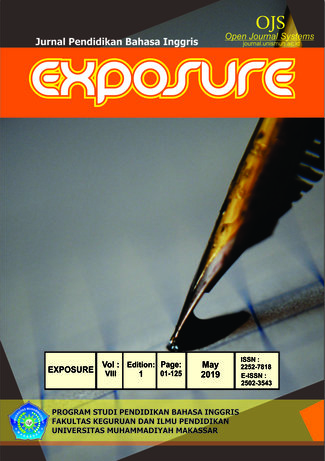A JOURNEY TO MATURITY IN A WALK TO REMEMBER BY NICHOLAS SPARKS
DOI:
https://doi.org/10.26618/exposure.v8i1.1708Kata Kunci:
journey, literary element, maturity, young adult literatureAbstrak
This study aims to examine the journey to maturity of the main character, Landon Carter, in A Walk to Remember by Nicholas Sparks, by analyzing the literary elements that construct it. Employing a textual analysis method, this study is framed within Allport’s (1961) theory of maturity, and to discuss the analysis, Bean and Moni’s (2003) theory of young adult literature is also employed. The findings show that Landon’s journey to maturity is depicted mostly through the use of one literary element, namely characterization peculiar to Reams’ (2015). Based on Allport’s (1961) general criteria of maturity, throughout the story, Landon shows six types of maturity: (1) extension of the sense of self, (2) warm relatedness of self to others, (3) emotional security, (4) realistic perception of skills, (5) self-insight, and (6) unifying philosophy of life, and three types of immaturity: (1) an ego-centric sense of self, (2) emotional insecurity, and (3) lack of self-insight. Based on the analysis, several moral values can be obtained by young adult readers with different perspectives from reading Landon’s journey to maturity, such as the importance of being mature and the struggles of attaining maturity.
Referensi
Alexander, F. (1967). Emotional maturity (6th edition). Retrieved from https://repositories.lib.utexas.edu
Allport, G. W. (1961). Pattern and growth in personality. New York: Holt, Rhinehart & Winston.
Alwisol. (2009). Psikologi kepribadian. Malang: UMM Press.
Bean, T. W. & Moni, K. (2003). Developing student’s critical literacy: Exploring identity construction in young adult fiction. Journal of Adolescent & Adult Literacy. 46(8), 638-648. Retrieved from https://www.researchgate.net/publication/43445426
Fajarrani, R. (2013). Coming of age: An analysis of a young adult character development in Ellen Hopkin’s young adult novel Crank. Bandung: Indonesia University of Education.
Juwati. (2014). The influence of love on Landon Carter’s behavior in Nicholas Sparks’ A Walk to Remember (1999): A Behaviorist Perspective. Surakarta: Muhammadiyah University of Surakarta.
Nilsen, A. P. & Donelson, K. L. (2008). Literature for today’s young adults. United States of America: Pearson Education.
Puspitasari, Y., F. (2006). The influence of Jamie Sullivan’s emotion towards her motivation to struggle for life as seen in Nicholas Sparks’ A Walk to Remember. Yogyakarta: Sanata Dharma University.
Reams. J. (2015). Characterization in Fiction. Honors Thesis, Texas State University.
Sparks, N. (1999). A Walk to Remember. New York: Grand Central Publishing.
Stoffel, C. (2014). Young adult literature: Reflecting adolescent protagonists’ enforced journeys to uncertain cultural and personal destinations. France: Ecole de Commerce et de Gestion.
Widodo, Bernard S. F. (2011). Factors influencing the recovery process of Jamie in A Walk to Remember. Yogyakarta: Sanata Dharma University.
Zulva, U. (2015). Landon Carter’s self confidence in Nicholas Sparks’ A Walk to Remember. Surabaya: UIN Sunan Ampel.
Unduhan
Diterbitkan
Terbitan
Bagian
Lisensi
Authors who publish with this journal agree to the following terms:
In order to assure the highest standards for published articles, a peer review policy is applied. In pursue of the compliance with academic standards, all parties involved in the publishing process (the authors, the editors and the editorial board and the reviewers) agree to meet the responsibilities stated below in accordance to the Journal publication ethics and malpractice statement.
Duties of Authors:
- The author(s) warrant that the submitted article is an original work, which has not been previously published, and that they have obtained an agreement from any co-author(s) prior to the manuscript’s submission;
- The author(s) should not submit articles describing essentially the same research to more than one journal;
- The authors(s) make certain that the manuscript meets the terms of the Manuscript Submission Guideline regarding appropriate academic citation and that no copyright infringement occurs;
- The authors(s) should inform the editors about any conflict of interests and report any errors they subsequently, discover in their manuscript.
Duties of Editors and the Editorial Board:
- The editors, together with the editorial board, are responsible for deciding upon the publication or rejection of the submitted manuscripts based only on their originality, significance, and relevance to the domains of the journal;
- The editors evaluate the manuscripts compliance with academic criteria, the domains of the journal and the guidelines;
- The editors must at all times respect the confidentiality of any information pertaining to the submitted manuscripts;
- The editors assign the review of each manuscript to two reviewers chosen according to their domains of expertise. The editors must take into account any conflict of interest reported by the authors and the reviewers.
- The editors must ensure that the comments and recommendations of the reviewers are sent to the author(s) in due time and that the manuscripts are returned to the editors, who take the final decision to publish them or not.
Authors are permitted and encouraged to post online a pre-publication manuscript (but not the Publisher’s final formatted PDF version of the Work) in institutional repositories or on their Websites prior to and during the submission process, as it can lead to productive exchanges, as well as earlier and greater citation of published work (see The Effect of Open Access). Any such posting made before acceptance and publication of the Work shall be updated upon publication to include a reference to the Publisher-assigned DOI (Digital Object Identifier) and a link to the online abstract for the final published Work in the Journal.

